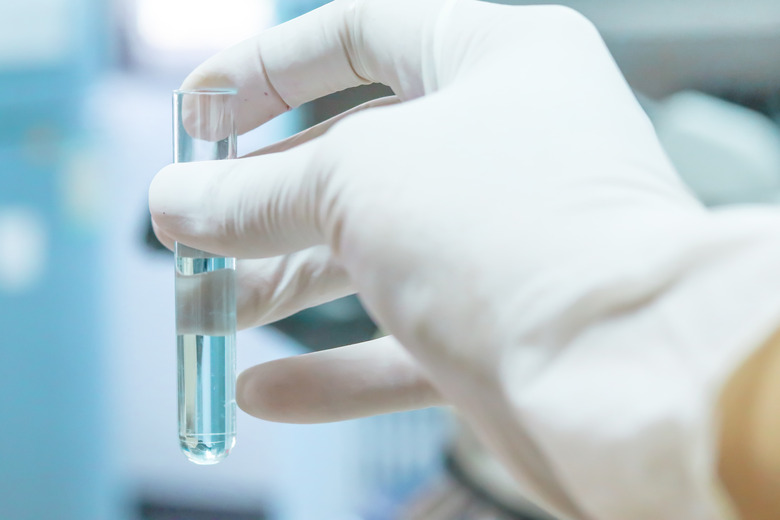How To Test For Hydrochloric Acid
As part of chemistry class, you may have to identify unlabeled solutions. If you have a solution you suspect may be hydrochloric acid but don't know for sure, the quickest way to test uses silver nitrate solution. The test is also a good introduction to precipitation, where an insoluble solid emerges from a liquid solution.
TL;DR (Too Long; Didn't Read)
The easiest way to test for hydrochloric acid is with silver nitrate solution. Add silver nitrate solution to the test solution in a test tube and observe the reaction. If a white precipitate forms, hydrochloric acid is present.
Properties of Hydrochloric Acid
Properties of Hydrochloric Acid
Hydrochloric acid (HCI) is a strong corrosive acid that occurs by dissolving hydrogen chloride in water. It is often used as a chemical reagent and is also made naturally in the body. Most gastric acid (human digestive acid) is made of hydrochloric acid.
Group 7 Elements
Group 7 Elements
The gas hydrogen chloride forms when hydrogen reacts with chlorine. The hydrogen atom and the chlorine atom are joined by a covalent bond to form molecules. Hydrochloric acid forms when hydrogen chloride dissolves in water. At this point, the molecules split into ions.
On the periodic table, the Group 7 elements are called the halogens, reactive non-metals that are always found in compounds with other elements. Chlorine, bromine and iodine are all examples of halogens. Their ions are called halide ions. For example, chloride is a halide ion of chlorine. The common test reaction for chloride ions is the interaction with silver nitrate.
Silver Nitrate Test
Silver Nitrate Test
If silver nitrate solution is added to a sample of water containing halide ions the silver halide is precipitated because silver halides are all insoluble in water. If chloride ions are present, the silver ions react with them to create a white precipitate of silver chloride.
To perform the test, clean a test tube with pure water. Add 20 drops of your test solution to the test tube, acidify it with a few drops of dilute nitric acid, then add a few drops of silver nitrate solution. The nitric acid reacts with, and removes, any other ions that might confuse the results. Shake the test tube gently to mix the contents, then check the solution. A white precipitate is indicative for chloride ions. On the other hand, a cream precipitate is indicative for bromide ions and a yellow precipitate is indicative for iodide ions.
Wear safety goggles and gloves when carrying out the silver nitrate test to avoid getting the solution in your eyes or on your skin.
Cite This Article
MLA
Gillespie, Claire. "How To Test For Hydrochloric Acid" sciencing.com, https://www.sciencing.com/test-hydrochloric-acid-8308625/. 11 May 2018.
APA
Gillespie, Claire. (2018, May 11). How To Test For Hydrochloric Acid. sciencing.com. Retrieved from https://www.sciencing.com/test-hydrochloric-acid-8308625/
Chicago
Gillespie, Claire. How To Test For Hydrochloric Acid last modified August 30, 2022. https://www.sciencing.com/test-hydrochloric-acid-8308625/
